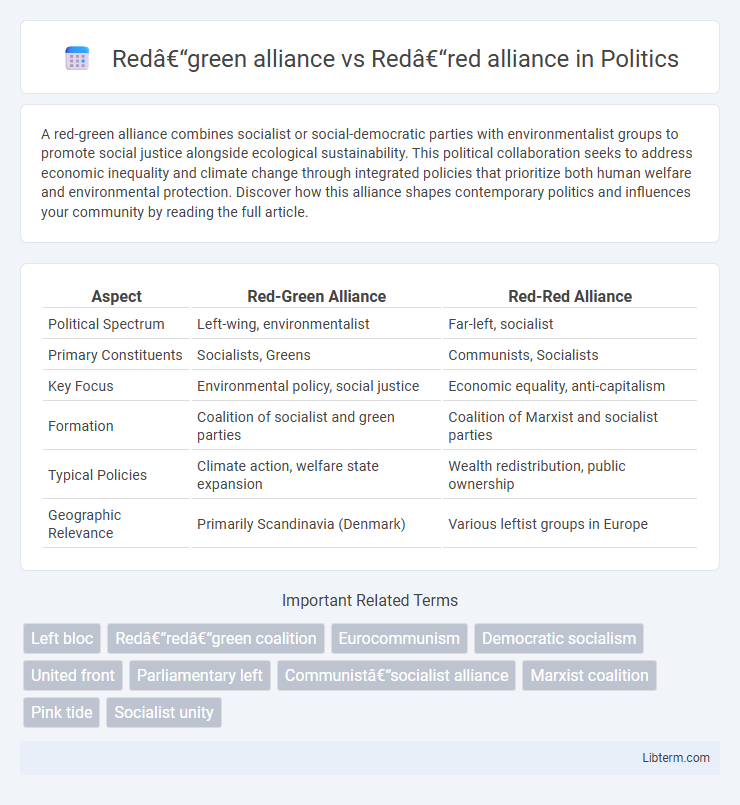A red-green alliance combines socialist or social-democratic parties with environmentalist groups to promote social justice alongside ecological sustainability. This political collaboration seeks to address economic inequality and climate change through integrated policies that prioritize both human welfare and environmental protection. Discover how this alliance shapes contemporary politics and influences your community by reading the full article.
Table of Comparison
| Aspect | Red-Green Alliance | Red-Red Alliance |
|---|---|---|
| Political Spectrum | Left-wing, environmentalist | Far-left, socialist |
| Primary Constituents | Socialists, Greens | Communists, Socialists |
| Key Focus | Environmental policy, social justice | Economic equality, anti-capitalism |
| Formation | Coalition of socialist and green parties | Coalition of Marxist and socialist parties |
| Typical Policies | Climate action, welfare state expansion | Wealth redistribution, public ownership |
| Geographic Relevance | Primarily Scandinavia (Denmark) | Various leftist groups in Europe |
Introduction to Red–Green and Red–Red Alliances
Red-green alliances typically involve cooperation between social democratic or socialist parties and green environmental parties, emphasizing sustainability and social justice in policymaking. Red-red alliances unite two left-wing socialist or social democratic parties, focusing on advancing progressive economic reforms and expanding welfare policies. Both alliances aim to consolidate leftist power but differ in their ideological priorities and electoral strategies.
Historical Background of Left-Wing Coalitions
Red-green alliances originated in the late 20th century as collaborations between socialist or social-democratic parties and environmentalist groups to address both economic equality and ecological sustainability. Red-red alliances typically involve coalitions between traditional communist or socialist parties aiming to strengthen left-wing policies through unified labor and welfare reforms. Historically, red-green coalitions gained momentum in European countries like Germany and Sweden during the 1980s and 1990s, whereas red-red alliances have been prominent in Eastern Europe and Scandinavia, reflecting different strategic priorities within left-wing movements.
Ideological Foundations: Red–Green vs Red–Red
The Red-Green alliance merges socialist or social-democratic principles with environmentalist and ecological values, emphasizing sustainable development and climate justice. In contrast, the Red-Red alliance unites leftist and socialist parties prioritizing class struggle, wealth redistribution, and expansive social welfare policies without a primary focus on environmental issues. These ideological foundations shape their policy priorities, with Red-Green alliances advocating for green economy transitions while Red-Red alliances concentrate on economic equality and social rights.
Political Parties and Key Players
The red-green alliance typically involves collaboration between socialist or social-democratic parties and green parties, focusing on progressive climate policies and social justice, with key players including Germany's Social Democratic Party (SPD) and Alliance 90/The Greens. In contrast, the red-red alliance usually unites traditional left-wing parties, such as socialists and democratic socialists, emphasizing economic equality and workers' rights, exemplified by partnerships between the SPD and The Left Party in Germany. Both alliances influence political dynamics by shaping legislative agendas and coalition formations in several European countries.
Policy Priorities and Programmatic Differences
The Red-green alliance, typically involving social democrats and green parties, prioritizes environmental sustainability, climate action, and progressive social policies like renewable energy investments and social justice reforms. In contrast, the Red-red alliance, formed between social democrats and left-wing socialist or communist parties, emphasizes wealth redistribution, expansive welfare policies, and stronger labor rights, focusing on economic equality and anti-austerity measures. Programmatically, red-green coalitions balance ecological modernization with social welfare, while red-red alliances prioritize robust public sector expansion and radical social-economic reforms.
Environmental Agendas in Red–Green Alliances
Red-green alliances prioritize environmental sustainability by integrating green policies with socialist principles, emphasizing renewable energy adoption, carbon emission reductions, and biodiversity preservation. In contrast, red-red alliances often focus more on social welfare and economic equality without explicitly centering environmental agendas. The red-green coalition's commitment to climate action and ecological reforms positions it as a key driver in progressive environmental legislation and green infrastructure investments.
Economic and Social Policies in Red–Red Alliances
Red-Red alliances, often formed between socialist and communist parties, emphasize expansive social welfare programs and increased public sector involvement in the economy, promoting wealth redistribution and stronger labor protections. These alliances prioritize policies like universal healthcare, free education, and robust social safety nets, contrasting with Red-Green alliances that integrate environmental sustainability with progressive economic reforms. Economic strategies in Red-Red coalitions focus on reducing income inequality through higher taxation on the wealthy and increased public investment to support social infrastructure and employment.
Electoral Strategies and Coalition Dynamics
Red-green alliances typically involve collaboration between left-wing parties and ecological movements, leveraging environmental concerns to attract progressive voters and emphasizing sustainable policy platforms during campaigns. Red-red alliances unite socialist or social-democratic parties, focusing on consolidating the left-wing electorate through shared social justice and welfare state priorities. Coalition dynamics in red-green partnerships demand balancing environmental goals with traditional labor interests, while red-red alliances require negotiating ideological coherence amid overlapping but distinct party bases.
Case Studies: Europe’s Red–Green and Red–Red Examples
Europe's Red-Green alliances, such as Germany's coalition between the Social Democratic Party (SPD) and the Green Party, emphasize sustainable environmental policies combined with social democratic economic reforms. In contrast, Red-Red alliances, like the partnership between Germany's Left Party and SPD in regional governments, prioritize robust welfare state expansion and stronger labor protections without a primary focus on green policies. Case studies reveal that Red-Green coalitions often achieve progressive climate legislation, while Red-Red alliances focus on mitigating inequality and expanding public services.
Challenges and Future Prospects for Leftist Alliances
Red-green alliances often face challenges in reconciling environmental priorities with socialist economic policies, leading to internal conflicts over policy focus and resource allocation. Red-red alliances, typically between different socialist or communist factions, struggle with ideological purity versus pragmatic coalition-building, which can limit their broader electoral appeal. Future prospects for leftist alliances hinge on their ability to balance ideological commitments with inclusive platforms that address climate action, social justice, and economic inequality to attract diverse voter bases.
Red–green alliance Infographic

 libterm.com
libterm.com